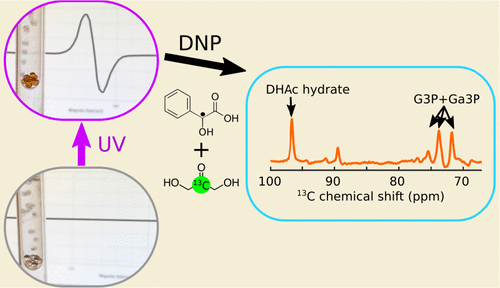当前位置:
X-MOL 学术
›
J. Am. Chem. Soc.
›
论文详情
Our official English website, www.x-mol.net, welcomes your
feedback! (Note: you will need to create a separate account there.)
Photo-generated radical in phenylglyoxylic acid for in vivo hyperpolarized 13C-MR with photo-sensitive metabolic substrates
Journal of the American Chemical Society ( IF 14.4 ) Pub Date : 2018-10-12 , DOI: 10.1021/jacs.8b09326
Irene Marco-Rius 1 , Tian Cheng 1 , Adam P Gaunt 1 , Saket Patel 2 , Felix Kreis 1 , Andrea Capozzi 3 , Alan J Wright 1 , Kevin M Brindle 1 , Olivier Ouari 2 , Arnaud Comment 1, 4
Journal of the American Chemical Society ( IF 14.4 ) Pub Date : 2018-10-12 , DOI: 10.1021/jacs.8b09326
Irene Marco-Rius 1 , Tian Cheng 1 , Adam P Gaunt 1 , Saket Patel 2 , Felix Kreis 1 , Andrea Capozzi 3 , Alan J Wright 1 , Kevin M Brindle 1 , Olivier Ouari 2 , Arnaud Comment 1, 4
Affiliation

|
Whether for 13C magnetic resonance studies in chemistry, biochemistry, or biomedicine, hyperpolarization methods based on dynamic nuclear polarization (DNP) have become ubiquitous. DNP requires a source of unpaired electrons, which are commonly added to the sample to be hyperpolarized in the form of stable free radicals. Once polarized, the presence of these radicals is unwanted. These radicals can be replaced by nonpersistent radicals created by the photoirradiation of pyruvic acid (PA), which are annihilated upon dissolution or thermalization in the solid state. However, since PA is readily metabolized by most cells, its presence may be undesirable for some metabolic studies. In addition, some 13C substrates are photosensitive and therefore may degrade during the photogeneration of a PA radical, which requires ultraviolet (UV) light. We show here that the photoirradiation of phenylglyoxylic acid (PhGA) using visible light produces a nonpersistent radical that, in principle, can be used to hyperpolarize any molecule. We compare radical yields in samples containing PA and PhGA upon photoirradiation with broadband and narrowband UV–visible light sources. To demonstrate the suitability of PhGA as a radical precursor for DNP, we polarized the gluconeogenic probe 13C-dihydroxyacetone, which is UV-sensitive, using a commercial 3.35 T DNP polarizer and then injected this into a mouse and followed its metabolism in vivo.
中文翻译:

苯基乙醛酸中的光生自由基用于具有光敏代谢底物的体内超极化 13C-MR
无论是化学、生物化学还是生物医学领域的 13C 磁共振研究,基于动态核极化 (DNP) 的超极化方法已经变得无处不在。 DNP 需要不成对电子源,这些电子源通常添加到样品中以稳定自由基的形式超极化。一旦极化,这些自由基的存在就是不需要的。这些自由基可以被丙酮酸(PA)光照射产生的非持久性自由基取代,这些自由基在固态溶解或热化时会消失。然而,由于 PA 很容易被大多数细胞代谢,因此它的存在对于某些代谢研究来说可能是不受欢迎的。此外,一些 13C 基板具有光敏性,因此可能会在 PA 自由基的光生成过程中降解,这需要紫外 (UV) 光。我们在这里表明,使用可见光对苯基乙醛酸(PhGA)进行光照射会产生非持久性自由基,原则上该自由基可用于超极化任何分子。我们比较了含有 PA 和 PhGA 的样品在宽带和窄带紫外-可见光源光照射下的自由基产率。为了证明 PhGA 作为 DNP 自由基前体的适用性,我们使用商用 3.35 T DNP 偏振器对紫外线敏感的糖异生探针 13C-二羟基丙酮进行偏振,然后将其注射到小鼠体内并跟踪其体内代谢。
更新日期:2018-10-12
中文翻译:

苯基乙醛酸中的光生自由基用于具有光敏代谢底物的体内超极化 13C-MR
无论是化学、生物化学还是生物医学领域的 13C 磁共振研究,基于动态核极化 (DNP) 的超极化方法已经变得无处不在。 DNP 需要不成对电子源,这些电子源通常添加到样品中以稳定自由基的形式超极化。一旦极化,这些自由基的存在就是不需要的。这些自由基可以被丙酮酸(PA)光照射产生的非持久性自由基取代,这些自由基在固态溶解或热化时会消失。然而,由于 PA 很容易被大多数细胞代谢,因此它的存在对于某些代谢研究来说可能是不受欢迎的。此外,一些 13C 基板具有光敏性,因此可能会在 PA 自由基的光生成过程中降解,这需要紫外 (UV) 光。我们在这里表明,使用可见光对苯基乙醛酸(PhGA)进行光照射会产生非持久性自由基,原则上该自由基可用于超极化任何分子。我们比较了含有 PA 和 PhGA 的样品在宽带和窄带紫外-可见光源光照射下的自由基产率。为了证明 PhGA 作为 DNP 自由基前体的适用性,我们使用商用 3.35 T DNP 偏振器对紫外线敏感的糖异生探针 13C-二羟基丙酮进行偏振,然后将其注射到小鼠体内并跟踪其体内代谢。































 京公网安备 11010802027423号
京公网安备 11010802027423号